Malaysia Airports had submitted a comprehensive strategic plan for the long-term development of Lapangan Terbang Sultan Abdul Aziz Shah (LTSAAS) to the Government.
The plan which has been verified through extensive benchmarking and stakeholder engagements, and further validated by independent parties is premised on three focus areas, namely Aerospace Ecosystem, Business Aviation and Urban Community Airport.
It is meant to propel LTSAAS into becoming the preferred aerospace and business aviation hub in Asia Pacific in the next 5 years.
“Moving forward, Malaysia Airports’ LTSAAS Regeneration Plan will grow the ecosystem further by three times, doubling the number of global and local operators to more than 100 that will create and support 19,000-strong high skilled workforce. It will spearhead Malaysia’s transition into high technology driven IR4.0 industries and high-income nation with a projected value of over RM10.0 billion to the national economy. This is very much aligned to the strategic thrusts identified in the government’s Shared Prosperity Vision 2030 and will achieve the aspirations of the Malaysian Aerospace Industry Blueprint 2030,” said Mohd Shukrie Mohd Salleh, Group Chief Executive Officer of Malaysia Airports.
LTSAAS will have the full range of capabilities in the entire value chain of the aircraft lifecycle, from manufacturing, assembly, operations, maintenance and end-of-life recycling of aircraft. It will also provide the full suite of business aviation services such as FBO, charter operations, hangarage, parts and logistics, flight simulation and ground handling.
Additionally, Malaysia Airports will add to the value proposition by providing ready-built or build-to-suit facilities as a “plug and play” real estate solution to potential operators. This will help alleviate the need for operators to raise capital for facility development and free up their capital for investment in other technology assets or machinery. This is already being done with Subang Aerotech Park, with its developer partner, Axis REIT.
Meanwhile, the Urban Community Airport model preserves the market preference for a small, convenient airport with fast turnaround i.e. 15 minutes from aircraft to curbside. It will serve the population catchment within Klang Valley for domestic and short haul routes serviced by the ATR type aircraft.
Similar to what has been achieved through the implementation of Airports 4.0 at KL International Airport (KLIA), airport capacity will be enhanced by leveraging technology for operational improvements in passenger processing and slot management.
Mohd Shukrie also stated that Malaysia Airports is ready now to undertake the LTSAAS Regeneration plan, “We have sufficient internal cash reserves for this. The plan requires infrastructure investment of RM300.0 million staggered over the next five years. This is well within our capability as we still have a strong cash and money market position of RM1.6 billion with RM914.0 million available for the Malaysian operations.”
“The funding for ready-built or build-to-suit facility can be easily facilitated via a combination of internal cash as well as project financing options. Despite the pandemic, we retain credit ratings of AAA by RAM Ratings and A3 by Moody’s investor Services, which is on par with Malaysia’s country credit ratings,” he added.









